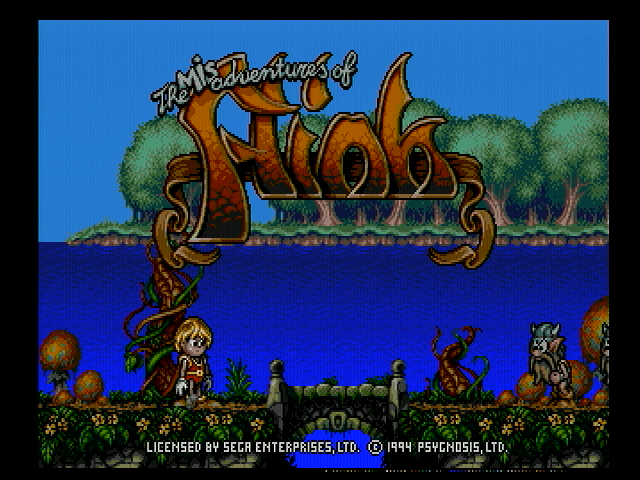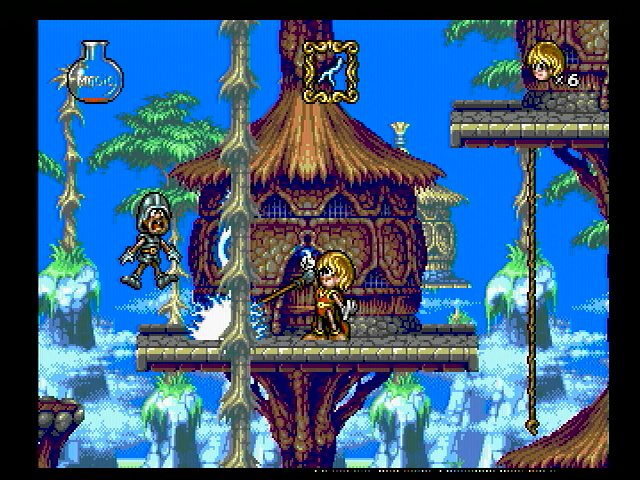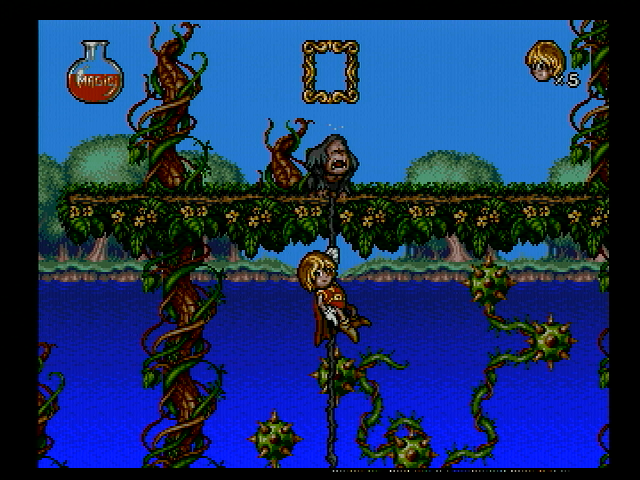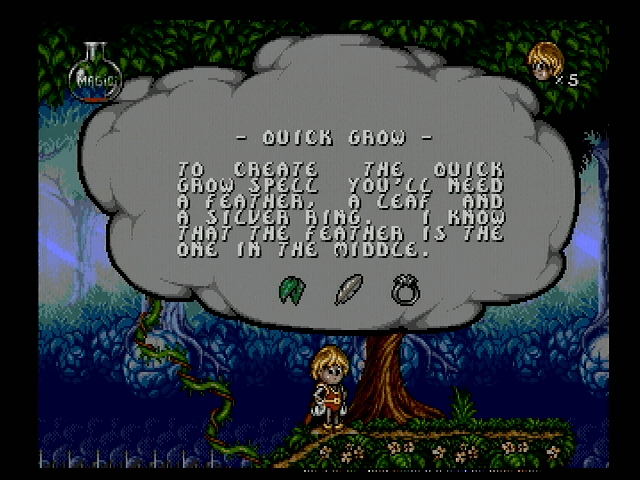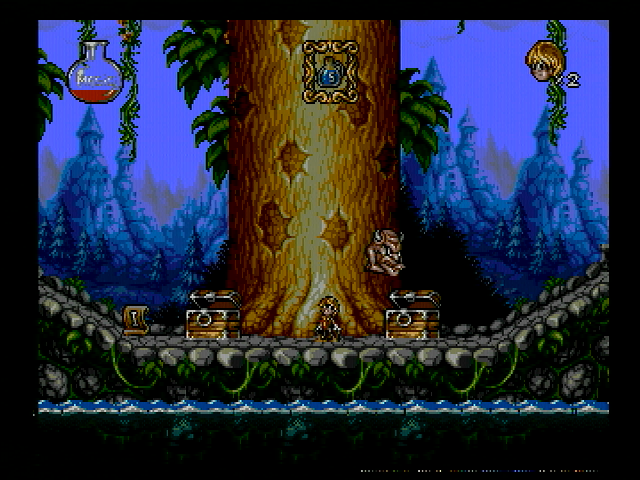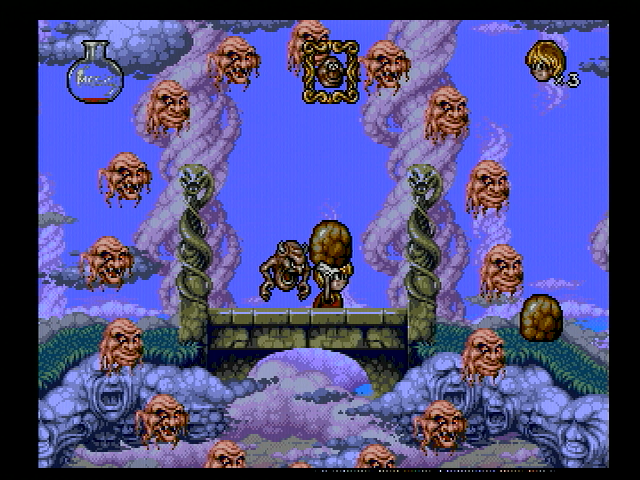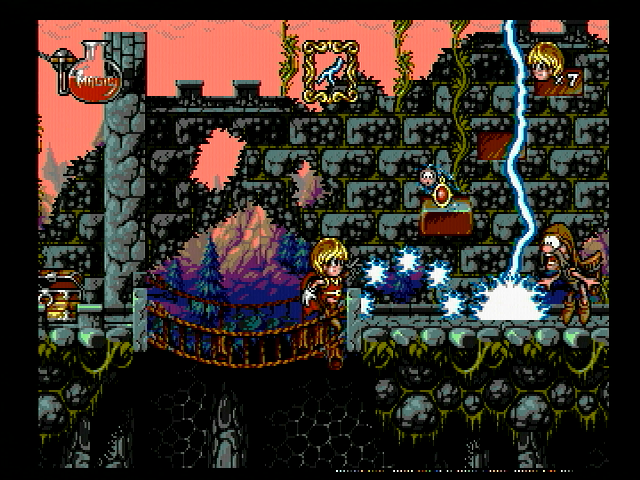Misadventures of Flink - Psygnosis - 1994 - First time playing?: No
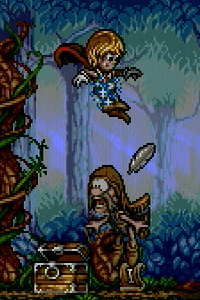 The island of Imagica is in turmoil. The wizard known as Wicked Wainwright has imprisoned the souls of the land’s four rulers into crystals which have been scattered and guarded by his strongest followers. The thick cloud of smoke emitting from his volcanic lair, covering the island’s sky, serves as a reminder of Wainwright’s rule. But, there is one threat he overlooked. A young, heroic wizard-in-training by the name of Flink, who can save the people. He does this by robbing merchants, practising dark magic with the stolen goods and then weaponizing the spirits of all those he’s killed along the way. Okay, maybe Flink is a little stinker, actually.
The island of Imagica is in turmoil. The wizard known as Wicked Wainwright has imprisoned the souls of the land’s four rulers into crystals which have been scattered and guarded by his strongest followers. The thick cloud of smoke emitting from his volcanic lair, covering the island’s sky, serves as a reminder of Wainwright’s rule. But, there is one threat he overlooked. A young, heroic wizard-in-training by the name of Flink, who can save the people. He does this by robbing merchants, practising dark magic with the stolen goods and then weaponizing the spirits of all those he’s killed along the way. Okay, maybe Flink is a little stinker, actually.
Spanning a surprisingly lengthy quest of 55 levels spread across the overworld, your objective is to find and rescue the four rulers of Imagica in order to access the final confrontation with Wainwright. Along the way you’ll gradually learn more and more magic spells which allow you to fight enemies, find secrets and access branching paths leading to entirely new levels. While still a mostly linear action platformer, there’s an excellent sense of progression with each spell learnt and seeing your repertoire of magic increase and allow for further options in moment-to-moment gameplay.
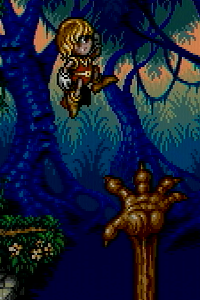 The game starts out as a fairly standard platformer of the time. Your control of Flink is mostly limited to moving left or right and jumping, with jumping on top of enemies being the primary method of combat. You can also use the A button to grab onto and climb ropes, pick up and throw rocks and empty chests and send stunned enemies spinning like a beyblade across the screen and taking out anything they crash into along the way. As you get to grips with these basic controls, undoubtedly your first hurdle will be getting over how slow Flink moves. Flink gradually builds up speed the longer he keeps running for, and while his top speed is pretty comfortable, it takes a lot of sluggish sauntering to get up to that top speed. The fact that this game was only released in PAL regions makes the movement speed all the stranger, as while it's already a bit slow moving when playing the game on a 60hz Japanese Mega Drive like the model I own, it's even more sluggish when running at 50hz on an unmodded PAL region Mega Drive, resulting in the game running 1/6th slower. The game is not region locked, thankfully, so if you have a 60hz Mega Drive you'll have no issues getting the game to run at all. The game really feels like it was designed for 60hz the whole time.
The game starts out as a fairly standard platformer of the time. Your control of Flink is mostly limited to moving left or right and jumping, with jumping on top of enemies being the primary method of combat. You can also use the A button to grab onto and climb ropes, pick up and throw rocks and empty chests and send stunned enemies spinning like a beyblade across the screen and taking out anything they crash into along the way. As you get to grips with these basic controls, undoubtedly your first hurdle will be getting over how slow Flink moves. Flink gradually builds up speed the longer he keeps running for, and while his top speed is pretty comfortable, it takes a lot of sluggish sauntering to get up to that top speed. The fact that this game was only released in PAL regions makes the movement speed all the stranger, as while it's already a bit slow moving when playing the game on a 60hz Japanese Mega Drive like the model I own, it's even more sluggish when running at 50hz on an unmodded PAL region Mega Drive, resulting in the game running 1/6th slower. The game is not region locked, thankfully, so if you have a 60hz Mega Drive you'll have no issues getting the game to run at all. The game really feels like it was designed for 60hz the whole time.
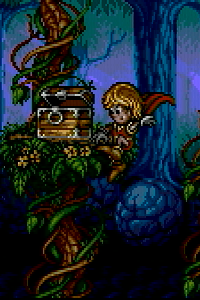 There's ways to circumvent the sluggish movement however. The main trick is that you build up speed much faster when jumping than you do on the ground, so a short hop before you start running is a huge help in timing precise running jumps. If you’ve ever played Sonic Adventure, it’s similar to how Amy Rose builds up momentum in that game. If that's still not enough and the game continues to feel bad, you can also try this rom hack which increases Flink’s acceleration speed. Personally, once I got into a habit of hopping to get running starts for long jumps, I had very little issue with the controls aside from the occasional precision platforming that doesn't give you much room to safely build up that speed. It's nowhere near as frustrating or restrictive as other platformers with similarly slow acceleration such as Kid Kool or Psycho Fox.
There's ways to circumvent the sluggish movement however. The main trick is that you build up speed much faster when jumping than you do on the ground, so a short hop before you start running is a huge help in timing precise running jumps. If you’ve ever played Sonic Adventure, it’s similar to how Amy Rose builds up momentum in that game. If that's still not enough and the game continues to feel bad, you can also try this rom hack which increases Flink’s acceleration speed. Personally, once I got into a habit of hopping to get running starts for long jumps, I had very little issue with the controls aside from the occasional precision platforming that doesn't give you much room to safely build up that speed. It's nowhere near as frustrating or restrictive as other platformers with similarly slow acceleration such as Kid Kool or Psycho Fox.
I personally had more issues with the collision detection during such platforming sequences. Usually in platformers, if you land on even just a single pixel on the edge of a platform, that's enough for the game to count it as solid ground, but consistently in Flink I find that the collision detection on platforms is much smaller than the actual sprite, resulting in a lot of “I swear I made that jump!” type situations where Flink seemingly clips through solid ground. Grabbing onto ropes is also finicky, thanks to both ambiguous hitboxes and the necessity to hold the A button in order to actually grab onto the ropes as opposed to just jumping straight through them. This isn't the worst example of awkward collision detection I’ve seen, this isn't on the same level as The Wizard of Oz on SNES, and in my experience it’s perfectly reliable when it comes to jumping on enemies, but when combined with the sluggish movement and moving platforms it can definitely cause a fair few cheap deaths.
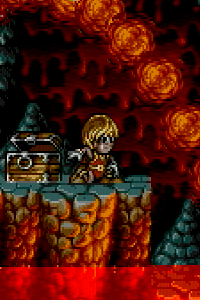 This might sound pretty damning right off the bat, but I'm actually quite fond of Flink in spite of it all. It definitely starts slow and I don't doubt that the controls and collision detection will turn a lot of people off immediately, but I really think there is something unique here if you're willing to put the effort into adapting to the quirks.
This might sound pretty damning right off the bat, but I'm actually quite fond of Flink in spite of it all. It definitely starts slow and I don't doubt that the controls and collision detection will turn a lot of people off immediately, but I really think there is something unique here if you're willing to put the effort into adapting to the quirks.
As alluded to earlier, learning magic spells is a huge aspect of this game and is also where the game really picks up for me. Throughout the game are collectable magic scrolls containing recipes for various spells. Some are found in chests, others can be stolen from merchants and a small handful are learnt from the four rulers after you rescue them. Each spell is made by throwing three ingredients into a cauldron in a specific order, though many of the recipes leave out details about the order you must insert the ingredients. The ingredients are found in much the same way that the scrolls are found, while the cauldron is something you always have immediate access to via the pause menu. As what order you need to add them to the brew is often ambiguous, this requires some experimentation, or to put it more cynically, trial and error. At least if you mess up you get some amusing animations of the spell going wrong, one of which involves Flink accidentally summoning a bunch of lemmings from Psygnosis’ most popular game.
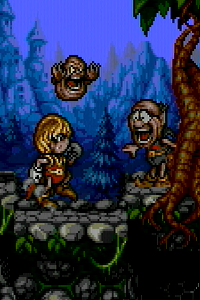 Once you've successfully made a spell, you have it permanently available as an equipable infinite use ability. The only limit on your usage is your magic metre, up in the top left of the screen. This metre fills up as you either find red potions or collect spirits dropped by defeated enemies, however magic also serves as your health since the damage system here works very similarly to Sonic the Hedgehog, with Flink dropping his magic energy when he gets hit, or dying when he's hit and completely out of magic. Regardless, you'll use this to cast a variety of spells. Some of them are situational and only really come into use in very specific situations such as accessing hidden levels and secrets, such as the spell that shrinks you in size which is simply used for entering a small hole in a tree that leads to a set of hidden levels. There's also a shield spell and a spell that lets you conjure platforms, both cool ideas that are unfortunately fairly underutilised due to how late in the game you unlock them. Most of the spells you get however are used for combat, such as summoning lightning storms, tornadoes and… a demon.
Once you've successfully made a spell, you have it permanently available as an equipable infinite use ability. The only limit on your usage is your magic metre, up in the top left of the screen. This metre fills up as you either find red potions or collect spirits dropped by defeated enemies, however magic also serves as your health since the damage system here works very similarly to Sonic the Hedgehog, with Flink dropping his magic energy when he gets hit, or dying when he's hit and completely out of magic. Regardless, you'll use this to cast a variety of spells. Some of them are situational and only really come into use in very specific situations such as accessing hidden levels and secrets, such as the spell that shrinks you in size which is simply used for entering a small hole in a tree that leads to a set of hidden levels. There's also a shield spell and a spell that lets you conjure platforms, both cool ideas that are unfortunately fairly underutilised due to how late in the game you unlock them. Most of the spells you get however are used for combat, such as summoning lightning storms, tornadoes and… a demon.
Yeah, the demon is my favourite, hands down, not even close. This small child is more than happy to dabble in powers beyond his comprehension in order to summon a grumpy, lumpy satanic potato that follows you everywhere and will attack enemies for you. If that's not enough, then try casting the demon summoning spell twice in a row to transform your potato demon into an even more fierce horned demon. Yeah, you need a lot of magic to summon the demon, but as he sticks around long after the spell has been cast, it's more than worth it. Given that the magic pickups dropped by enemies is implied to be some kind of spiritual energy, I choose to interpret this as a blood sacrifice. This kid is badass.
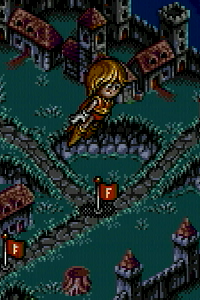 With this almost Metroid-esque progression of collecting items, unlocking new abilities and gaining access to new areas as a result, it feels odd that in spite of that the game features no save function and limited continues. There is a practice mode accessible in the options menu that lets you play the game with unlimited continues, but playing in practice mode locks you out of the endgame, resulting in the game ending earlier and anticlimactically. Flink is far from one of the hardest Mega Drive games I've played, but it's nonetheless quite high stakes and stressful due to the sheer length of the game, the scarcity of extra lives and plenty of opportunities for instant death.
With this almost Metroid-esque progression of collecting items, unlocking new abilities and gaining access to new areas as a result, it feels odd that in spite of that the game features no save function and limited continues. There is a practice mode accessible in the options menu that lets you play the game with unlimited continues, but playing in practice mode locks you out of the endgame, resulting in the game ending earlier and anticlimactically. Flink is far from one of the hardest Mega Drive games I've played, but it's nonetheless quite high stakes and stressful due to the sheer length of the game, the scarcity of extra lives and plenty of opportunities for instant death.
I'm not opposed to more arcade style high stakes and limited continues, but I really don't think it adds much to Flink. Again, this isn't really an arcade style game, it's something more designed for lengthier play sessions at home. Furthermore, it's so extremely easy to cheese that it leaves you wondering why they bothered locking you out of the end game in practice mode. You can freely select and revisit any level you've previously been to on the world map, a necessity for this style of game or else you would end up in dead ends unable to progress if you were to miss important scrolls and ingredients. Extra lives are scarce, but they also respawn when you revisit a level, and it just so happens that the first level has an infinitely spawning 1UP right at the start of the level in plain sight, just requiring you to bounce off an enemy to get some extra jump height. Grab the life, exit the level via the pause level, enter the level again and repeat. If replaying the game over and over until you've achieved mastery isn't your thing, you'll get no judgement from me for grinding extra lives. I certainly did on my first playthrough.
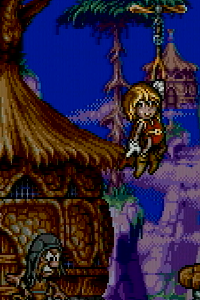 While the basics of Flink’s platforming are undoubtedly rough, I find the magic system and satisfying progression tied to it to be engaging and enjoyable enough to still have a good time with the game. Back when I first tried Flink, discovering new spells and going through the effort of getting the ingredients needed to try them out for the first time was consistently keeping me enticed to see what I'd discover next, and even on relays the magic is fun enough to use to still be an engaging mechanic. There’s a decent amount of variety as well, and while it’s still mostly standard platforming tropes like minecart rides, enemies jumping at you from the background, using propellers to fly through the air and solving seesaw physics puzzles, they still help prevent things getting monotonous. A highlight of the game for me is a section where you have to use a spell that temporarily kills Flink so that his ghost can explore the afterlife. The fact that this afterlife is made out of fluffy clouds would normally suggest that it’s heaven, but I dunno, the nightmarish visuals here indicate something less pleasant and I’m all here for it.
While the basics of Flink’s platforming are undoubtedly rough, I find the magic system and satisfying progression tied to it to be engaging and enjoyable enough to still have a good time with the game. Back when I first tried Flink, discovering new spells and going through the effort of getting the ingredients needed to try them out for the first time was consistently keeping me enticed to see what I'd discover next, and even on relays the magic is fun enough to use to still be an engaging mechanic. There’s a decent amount of variety as well, and while it’s still mostly standard platforming tropes like minecart rides, enemies jumping at you from the background, using propellers to fly through the air and solving seesaw physics puzzles, they still help prevent things getting monotonous. A highlight of the game for me is a section where you have to use a spell that temporarily kills Flink so that his ghost can explore the afterlife. The fact that this afterlife is made out of fluffy clouds would normally suggest that it’s heaven, but I dunno, the nightmarish visuals here indicate something less pleasant and I’m all here for it.
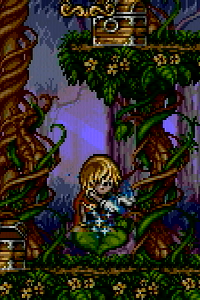 Presentation wise however, the game is far more widely acclaimed. Flink is absolutely gorgeous and shows total mastery of the pixel art medium and how to get the most out of the hardware's palette limitations. The lush fantasy environments, charming Asterix-esque character designs, fluid animations and wonderfully surreal and dreamy world design with occasional dark touches such as distorted anguished faces visible in background details like trees and clouds, Flink is a contender for best looking game on the console. The music is a bit more contested on the other hand, it's a bit abrasive and tends to seemingly change genre at random mid track, but I like it personally and feel it fits the vibe of the game as something whimsical and fantastical but with a slightly dark and cynical vibe. The game does also have a Mega CD port if you’d prefer a less crunchy soundtrack.
Presentation wise however, the game is far more widely acclaimed. Flink is absolutely gorgeous and shows total mastery of the pixel art medium and how to get the most out of the hardware's palette limitations. The lush fantasy environments, charming Asterix-esque character designs, fluid animations and wonderfully surreal and dreamy world design with occasional dark touches such as distorted anguished faces visible in background details like trees and clouds, Flink is a contender for best looking game on the console. The music is a bit more contested on the other hand, it's a bit abrasive and tends to seemingly change genre at random mid track, but I like it personally and feel it fits the vibe of the game as something whimsical and fantastical but with a slightly dark and cynical vibe. The game does also have a Mega CD port if you’d prefer a less crunchy soundtrack.
I do think Flink is at least worth a look by the end. Starting out it really does not put its best foot forward due to how limited magic is in the early game, simply leaving you with basic and sloppy platforming for the first few levels. If you’re willing to adapt however, there’s some really unique ideas under the surface that deserve credit, and the whole game is brimming with so much charm that it’s hard for me not to like. Consider this a cautious recommendation, but know I do genuinely quite enjoy the game myself and would happily play it again.
- Page written by MSX_POCKY, 7th September 2024
